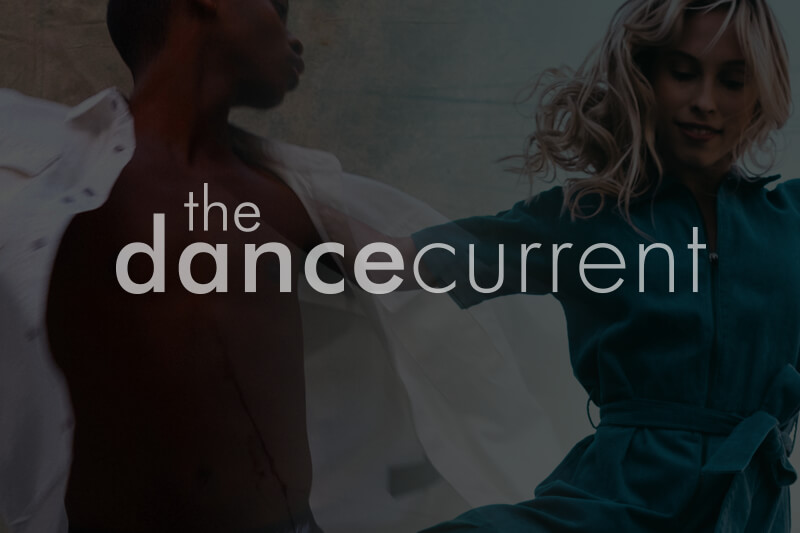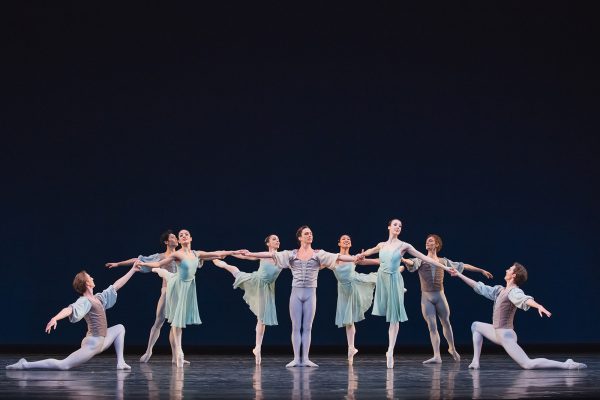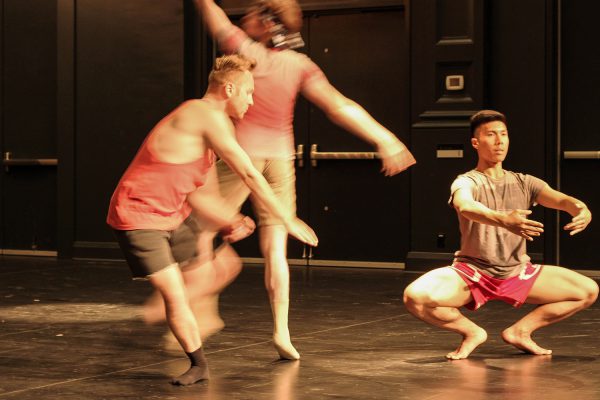Time is such an inherently central component of what has traditionally been described as theatrical dance that to make a dance about time itself might appear to be, well, a waste of time. But not, of course, if you subscribe to the open-ended proposition, so beloved by post-modernists – and there are still plenty around – that virtually any movement or action can legitimately be called dance.
In his latest work as Dancemakers’ artistic director, Michael Trent neatly avoids any accusation of redundancy by exploring the subject of time without resort to dance in the ordinary, everyday sense of the word – the sense understood by the thousands of people who escape everyday reality by watching beautiful bodies moving to music.
“It’s About Time: 60 Dances in 60 Minutes” might more aptly be described as physical theatre. Although it would be imprudent to try some of the moves at home – hurling oneself onto the floor or jumping on the spot to the point of exhaustion, for example – others could readily be accomplished by non-dancers; walking, running, carrying things, taking clothes on or off, standing still and, especially, sitting.
The open floor of Harbourfront Centre’s adaptable Enwave Theatre is unadorned for the proceedings and brightly lit. The small trapped area downstage, sometimes deployed as an orchestra pit, is lowered about a foot to create a defined rectangular area that the dancers traverse in opposite directions at various speeds or fling themselves into.
Costuming is casual and variable, according to how cast members choose to garb themselves with this or that, extracted from a pile of assorted clothes and shoes that look as if they were headed for Goodwill when Dancemakers’ hijacked them.
One gathers from the various program notes – and Dancemakers loves program notes – that “It’s About Time” attempts in some degree to illustrate and heighten our awareness of the difference between objective clock time, the kind by whose measure eggs are boiled and Olympic records set, and the subjective time we experience in our minds.
The former is, by and large, accepted as a scientific principle or, at least, as a workable way of ordering what might otherwise be the chaos of daily existence, particularly in modern societies with their planes to catch and meetings to attend. The latter is a matter of individual personal perception. If you’re in a hurry to get somewhere, taking public transit might seem infuriatingly slow, even if the bus is on schedule. If you are not in rush, you will enjoy reading or staring out the window and not fret about the time.
“It’s About Time” touches on this common experience. It’s not unreasonable to surmise that those in the audience who were enraptured by it found the hour passed quickly. For those not so moved the hour will have seemed to drag by. Yet all of us, I suspect, experienced an odd subjective prolongation of time during those occasions when the dancers disappeared altogether and we were left staring at a stage only moments before alive with frenetic motion.
“It’s About Time”, however, is also task oriented and involves feats of endurance. How long can a man hold his breath, especially when his head is stuck in a water-filled fish tank? How long can one woman hold on to another? How long can someone endure being tickled? Conversely, how can a prescribed action be compressed into less time?
The work is structured so that a series of “events,” some occurring simultaneously, is repeated within different clock-time frames. Although there is a Dancemakers recorder sitting in the front row with stopwatch and clipboard, as an audience member you are discouraged from checking your wrist.
The “events” go by strange names such as “Koala”, “Knee-Burn” and “Suicides”. You won’t discover this by reading the twenty-page program, but the titles appear on the recorder’s time sheet, subsequently viewable on Dancemakers’ website.
A highpoint of the show, even when repeated, is called “How-To”. Steeve Paquet, who also has to do a lot of setting up and arranging of chairs through the show, recites a recipe for one-minute shepherd’s pie, condensing it or elaborating it according to the time he’s allowed. The absurdity of the idea and the deadpan earnestness of his efforts are hilarious.
As a visual metaphor with comedic possibilities, one of Robert Abubo’s chores, when he’s not careening or crashing to the floor, is to carry on water-filled glass containers of proportions commensurate with the time allowed for the task. Understandably, he got a laugh when he came out with what looked like a shot glass for the hyper-compressed section and with the fish tank for the extended section.
Another such “event” involved the dancers grouping into a five-piece band: Abubo on drums, Paquet and Benjamin Kamino on harmonica and Dancemakers’ brace of Kates – Hilliard and Holden – on guitar. They didn’t produce much in the way of music but the point is more to see how they make what they have shrink or stretch into different pockets of time.
Beyond that, composer Josh Thorpe assembled an aural backdrop from “field recordings” contributed by sixty volunteers who were – he explains in his full-page program note – asked to imagine rather than measure the passage of time between pushing the on and off buttons. The results form a meandering, generally faint soundscape of everything from passing planes to kitchen clatter. Its subtle effect is to suggest the experience of time rolling idly by.
Meanwhile, Dancemakers’ admirable performing contingent, hands over ears, eyes closed and counting out loud, repeatedly get to imagine the passing of a minute in their own heads, raising a hand when they think the mission is accomplished; and, of course – no surprise – they’re never in sync. At the end of it all, audience members are invited to close their eyes and have a go themselves. I kept my eyes open, one on the second hand, another on the audience. Kamino, who throughout the show proved himself most consistently able to judge real time accurately, and a chap a few rows back were almost dead on. Other hands rose as much as twenty seconds later.
So, apart from the fun of it all, what else was to be gleaned from “It’s About Time?” Were there larger messages? I read Kate Hilliard’s repeated diagonal walks across the stage as a metaphor for the drudgery of time-dictated routine. I had no idea why Kamino decided to bury Holden under a heap of clothes. Holden’s throwing herself on top of Kamino made much more sense. The tickling bit puzzled me. Was the idea to see if someone could still count up seconds while having their sensitive zones involuntarily stimulated or was there more involved? Tickling, after all, can also be used as a form of torture. “Koala”, the woman-holding-woman bit, had emotional complexity because the one bearing the weight seemed ambivalent in her response and the one sliding down really seemed eager for support.
What “It’s About Time” never addressed is the ultimate mystery of time – that word we use, the mental construct we deploy, which nevertheless is ultimately unable to provide satisfactory answers to the sheer miracle of our existence. In being content to root itself in the mundane, prosaic and mostly obvious, “It’s About Time” never came close to what old-fashioned theatrical dance can sometimes achieve when, for all its supposedly stale conventions, it elicits the sense, if only momentarily, of being carried to a new realm of experience, beyond time and space.~
Editor's Note: For video and commentary about Dancemakers' creative process for "60 in 60" visit the company's site >> dancemakers.org
Tagged: Contemporary, Performance, ON , Toronto





